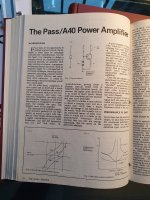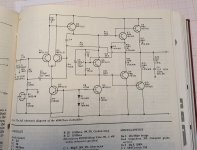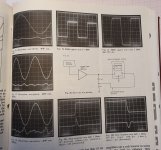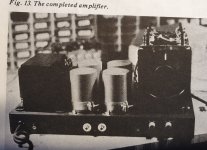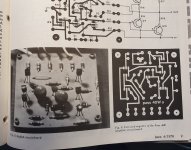This youtube video is also in Finnish hifi forum and someone says there it's inside like Jim Williams prototype.

Here in Finland is one (maybe more) Tom Evans riaa and it must sound good because owner have also Simon Yorke design turntable, but it went something wrong with riaa and he send it back to Tom for repair.
I think the same, why not make better mechanical construction inside ? These plastic parts inside are the cheapest one ...

Here in Finland is one (maybe more) Tom Evans riaa and it must sound good because owner have also Simon Yorke design turntable, but it went something wrong with riaa and he send it back to Tom for repair.
I think the same, why not make better mechanical construction inside ? These plastic parts inside are the cheapest one ...
How do you know?I understand you feeling, but you seem to be presuming that the plastic enclosure was a cost cutting decision. It wasn’t.
I would really like to know why a plastic case that lets through all kinds of noise and hum versus a metal case would be 'better'.
I do know it is a lot cheaper.
Jan
Interesting. But for all the sniggering about the high price of high end audio (and there's lots of opportunity for that, not just TEAD) to my mind this video represents a missed opportunity.
Evans started making products when acrylic cases were a thing (think DNM) and his internal copper plates were devised as a rudimentary Faraday cage. Effective? Perhaps not. But he's still using this method.
But his main claim to fame (such as it is) was his elaborate "Lithos" regulators which were/are evocative of Jung-Didden super regulators. I remember Jan or Gary musing that separate regulators for each channel were good... but that individual regulators for each stage might be better. And in the Pearl 3 thread the use of pre-regulators was noted as advantageous. Evans seems to have implemented these ideas. I would suggest that the performance of his equipment is closely tied to these components.
But our chortling tech glossed over them. It would have been very interesting to have put these regulators under the same tests that were done on an array of other regulators in Linear Audio to see how they measured up. Oh well.
As it is, he might have been lucky that the problem was only a capacitor. If Evans has actually done a lot of hand matching and one of those components had gone south I think the outcome could have been less successful. (I'm reminded that Mr. Thatcher was advised not to mess about with his newly acquired Vendetta.)
Evans started making products when acrylic cases were a thing (think DNM) and his internal copper plates were devised as a rudimentary Faraday cage. Effective? Perhaps not. But he's still using this method.
But his main claim to fame (such as it is) was his elaborate "Lithos" regulators which were/are evocative of Jung-Didden super regulators. I remember Jan or Gary musing that separate regulators for each channel were good... but that individual regulators for each stage might be better. And in the Pearl 3 thread the use of pre-regulators was noted as advantageous. Evans seems to have implemented these ideas. I would suggest that the performance of his equipment is closely tied to these components.
But our chortling tech glossed over them. It would have been very interesting to have put these regulators under the same tests that were done on an array of other regulators in Linear Audio to see how they measured up. Oh well.
As it is, he might have been lucky that the problem was only a capacitor. If Evans has actually done a lot of hand matching and one of those components had gone south I think the outcome could have been less successful. (I'm reminded that Mr. Thatcher was advised not to mess about with his newly acquired Vendetta.)
Last edited:
I'm sorry, but preregulation is not "an idea", nor is using regulators per channel "an idea". It was and is used.Evans seems to have implemented these ideas. I would suggest that the performance of his equipment is closely tied to these components.
A mild steel case would reduce the susceptibility of the electronics inside to externally radiated noise. RFI filtering is best accomplished with a strategically placed cap of 5-10 nF ceramic across the input cable screen to the metalwork. This option isn’t available on a plastic case unfortunately.There is theoretically a method to that madness. The plastic enclosure supposedly avoids parasitic magnetic effects that would adversely affect the low noise of the circuitry if the enclosure contained more steel parts. If true, and I don‘t immediately doubt that it isn’t, the natural consequence is a light weight enclosure. I imagine that Evans has the instrumented data showing a slight lowering of the noise, whether or not the ear can detect the lowering is another matter.
I’ve read years ago in reviews for both Tom Evans and DNM units, and which both utilized polymer enclosures, that the reason has to do with minimizing magnetic eddy domains which, presumably, increase minuscule parasitic inductance and hysteresis within the circuit. I’ve no idea if their approach is valid, or makes any appreciable difference if it is valid.How do you know?
I would really like to know why a plastic case that lets through all kinds of noise and hum versus a metal case would be 'better'.
I do know it is a lot cheaper.
Jan
Last edited:
@Ken Newton In order to create distortion or noise from these specific mechanisms you are going to need very high currents. And if you adhere to good wiring practices with small loop areas in high current circuits, you can very effectively control stray fields.
yikes. I should hold off posting until after the second cup of coffee.
the article was in Audio Amateur 1978, 46 years ago.
I think I need a nap
the article was in Audio Amateur 1978, 46 years ago.
I think I need a nap
They apparently are very good in generating good sounding content-free, non-sensical texts, I give 'm that.I’ve read years ago in reviews for both Tom Evans and DNM units, and which both utilized polymer enclosures, that the reason has to do with minimizing magnetic eddy domains which, presumably, increase minuscule parasitic inductance and hysteresis within the circuit. I’ve no idea if their approach is valid, or makes any appreciable difference if it is valid.
Jan
I build that amp at the time. Four of them.@HJH
That reminds me of the photo of the prototype of Nelson Pass's A-40 in Audio some 25 odd years ago. as he observed, "hardly portable"!
Audio Amateur # 4/1978.
Jan
Attachments
Last edited:
since you have it out can you share the photo of the prototype please? it's the reason I mentioned this article. thanks.
I was thinking of the photo of the board with components jumping off in all directions and the massive heatsink off to the side
@bogdan2011 Have to thank you for bringing Mend It Mark to my attention. Have been going through his You Tubes and they are great for developing technique. His method for removing SMDs with hot air is helpful.
Some of you may have noticed the nervous "after laugh" he has. This is a sign of high intelligence and it is reported that W. A. Mozart had the same laugh. Mark is in good company here...
Some of you may have noticed the nervous "after laugh" he has. This is a sign of high intelligence and it is reported that W. A. Mozart had the same laugh. Mark is in good company here...
All I know is I thoroughly enjoyed my original Groove for many years. When the opportunity came up to grab a newer SRX MKii I jumped at it and have been very pleased. Tom is a very small operation and almost everyone who acquires one of his phono stages usually become a long term customer. They rarely appear on the used market and sell quickly when they do. Tom continues to offer support for older versions and offers upgrade paths to the latest revisions.
@Ken Newton In order to create distortion or noise from these specific mechanisms you are going to need very high currents. And if you adhere to good wiring practices with small loop areas in high current circuits, you can very effectively control stray fields.
I had some difficulty with induction into the casework of a transformer coupled line stage, the culprit was the power transformer - cover off OK, cover on not so OK. Details here: https://www.diyaudio.com/community/...e-stage-w-parafeed-output-transformer.378535/
Clearly part of the problem was the audio input and output transformers... LOL
In this application I would have been much better off without the metal box, and in fact it measured just fine on the bread board, it was only when I started to assemble it into the case that I realized there was a problem. Obviously the phono stage has a power transformer and a whole lot more gain than my line stage design and plenty of wiring. In his favor there are no audio transformers in his design.
Strangely it appears he uses the same 3 wire teflon power wiring I use in some of my latest projects. 😀
On the question of perspex vs aluminum in my extremely limited experience custom machined perspex cases are much more expensive than aluminum.
Watching this episode now. 😀
On all my builds using toroids, putting the lid on reduces hum and noise by 6-8 dB. The reason for this is that without the lid, the stray transformer field couples to the surrounding electronics and anything in its way will pick the field up and generate an EMF causing noise. When you put the lid on, the field will couple to the metalwork where it generates a current that opposes the stray field leaving much less of it as a free stray mag field to cause noise. In metal housings BTW, this is the reason you should have one and only one earth bond point. If you have multiple ground connections from your circuit to the housing, you will almost certainly inject noise which arises because of the loop formed by the housing metalwork and the loop-associated circuits. A GOSS band works very well and results in further significant noise reductions and also works as described above by generating significant currents and associated fields in the GOSS band that oppose the transformers stray generating field. Metal housings also keep external fields from coupling into the electronics inside.
For signal coupling transformers you will couple stray fields into the metalwork, but AFAIK, DNM never used signal transformers. The copper Faraday shields DNM used would only have helped with intercepting electric fields and would have had no effect on mag fields at mains plus harmonic frequencies.
For signal coupling transformers you will couple stray fields into the metalwork, but AFAIK, DNM never used signal transformers. The copper Faraday shields DNM used would only have helped with intercepting electric fields and would have had no effect on mag fields at mains plus harmonic frequencies.
- Status
- Not open for further replies.
- Home
- Member Areas
- The Lounge
- The £25,000 preamp that went wrong - Tom Evans Mastergroove
